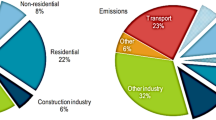Abstract
The present study quantified the significant environmental impacts of a two-story residential building located in Vancouver, Canada, with a projected 60-year life span: (i) an inventory of all the construction materials was analyzed, covering the building structure and exterior and interior envelopes as well as the energy consumption; (ii) four types of functional units were defined; (iii) the five top building materials were examined, and a sensitivity analysis was conducted to investigate the impact associated with the choice of building materials. Two life cycle phases, manufacturing and operation, were more significant in all of the impact categories, and two building assemblies, the walls and the roof, bore most of the environmental loads. In terms of the sensitivity analysis, the roofing asphalt had the largest impact, dominating three of the seven selected impact categories. Despite different definitions of functional units, the function of the dwelling buildings is always the same, to provide protection and housing for their habitants. Additionally, to improve the performance of an existing building, several strategies were proposed for the building renovation and maintenance, including alternative replacement materials regarding the building components with high environmental burdens, good patterns of the occupants’ consumption behaviors as well as considerations of the financial and environmental cost. Finally, limitations and challenges are discussed to explore better design decisions in future studies.
Similar content being viewed by others
References
Adalberth K, Almgren A, Holleris Petersen E (2001). Life cycle assessment of four multi-family buildings. International Journal Low Energy and Sustainable Buildings, 2: 1–21.
Asif M, Muneer T, Kelley R (2007). Life cycle assessment: A case study of a dwelling home in Scotland. Building and Environment, 42: 1391–1394.
Blanchard S, Reppe P (1998). Life cycle analysis of a residential home in Michigan. Centre for Sustainable Systems, University of Michigan, Report No. CSS98-05. Available: http://www.umich.edu/~css.
Boonstra C, Pettersen TD (2003). Tools for environmental assessment of existing building. UNEP Industry and Environment, 26(23): 80–83.
Ding GKC (2008). Sustainable construction-The role of environmental assessment tools. Journal of Environmental Management, 3: 451–464.
Fava JA (2004). Why take a life cycle approach? Paris: United Nations Environment Programme Division of Technology, Industry and Economics Production and Consumption Branch.
International Panel on Climate Change (IPCC) (2001). Climate Change 2001: Mitigation: Contribution of Working Group III to the Third Assessment Report of the Intergovernmental Panel on Climate Change. New York: Cambridge University Press.
ISO (2006). ISO 14044: Environmental Management-Life Cycle Assessment-Principles and Framework. Geneva: International Standardization Organization.
Morris M (2009). Life Cycle Analysis UBC’s Forest Science Centre. Available: https://circle.ubc.ca/handle/2429/21220. Accessed 14 Mar. 2013.
Ooteghem KV, Xu L (2012). The life-cycle assessment of a single-storey retail building in Canada. Building and Environment, 49: 212–226.
Ortiz O, Castells F, Sonnemann G (2009a). Sustainability in the construction industry: A review of recent developments based on LCA. Construction and Building Materials, 23: 28–39.
Ortiz O, Bonnet C, Bruno JC, Castells F (2009b). Sustainability based on LCM of residential dwellings: A case study in Catalonia, Spain. Building and Environment, 44: 584–594.
Peuportier B (2001). Life cycle assessment applied to the comparative evaluation of single family houses in the French context. Energy and Buildings, 33: 443–450.
Scheuer C, Keoleian GA, Reppe P (2003). Life cycle energy and environmental performance of a new university building: Modeling challenges and design implications. Energy and Buildings, 35: 1049–1064.
Thiers S, Peuportier B (2012). Energy and environmental assessment of two high energy performance residential buildings. Building and Environment, 51: 276–284.
Yaman H, Taş E (2007). A building cost estimation model based on functional elements. A|Z ITU Journal of the Faculty of Architecture, 4: 73–87.
Author information
Authors and Affiliations
Corresponding author
Rights and permissions
About this article
Cite this article
Zhang, W., Tan, S., Lei, Y. et al. Life cycle assessment of a single-family residential building in Canada: A case study. Build. Simul. 7, 429–438 (2014). https://doi.org/10.1007/s12273-013-0159-y
Received:
Revised:
Accepted:
Published:
Issue Date:
DOI: https://doi.org/10.1007/s12273-013-0159-y




